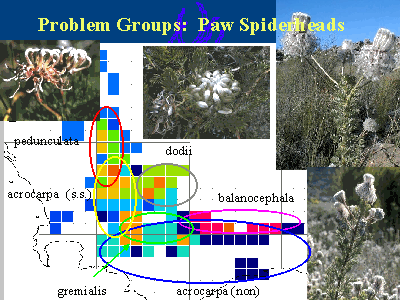 Some
problems though took us by surprise;
The Paw Spiderheads are one of the larger groups in the genus Serruria.
We expected atlassers to have some problems when John Rourke described Se gremialis,
which is very similar to Se acrocarpa (the former has knobbly styles). However,
both these species resprout so that they are very easy to distinguish from the other
species in the group.
Except that atlassers came across several populations of Se balanocephala on the
high peaks of the Langeberg which also resprouted. Were these Se acrocarpa or
unusual Se balanocephala or yet another species? We have found at least four of
these errant populations. Exactly the same problem was found with Se dodii! In all
cases these are small isolated populations. But what exactly does this mean?
Early on we discovered that what was supposed to be Se pedunculata was in fact
two species. The "new" form had a more compact habit with hairs flat (neat!) on
the petals, whereas Se pedu was a straggly bush with spreading (fuzzy) hairs on the
petals. We resolved this problem by telling atlassers to call the former Se dodii,
as we knew we could separate them (true Se dodii is only on the Hex River and
Keerom Mountains). But then around about Voelvlei we hit problems, the two species grew
side by side in some areas, but in other areas we could not tell them apart. In the Groot
Winterhoek Wilderness area the plants had intermediate features and could not be
unequivocally assigned to either species. To compound the problem this "new"
form is in fact Serruria acrocarpa! What was called acrocarpa had been incorrectly
identified from the herbarium material and is in fact the "new" species,
although it was described as a race called "ludwidgii". But we dared not tell
atlassers this because then the Se acro code would have been used in different ways and a
total mess would have followed.
The taxonomical mess must still be formally sorted out by John Rourke, but at least he
has lots of locality data to work with now! |

![]()
